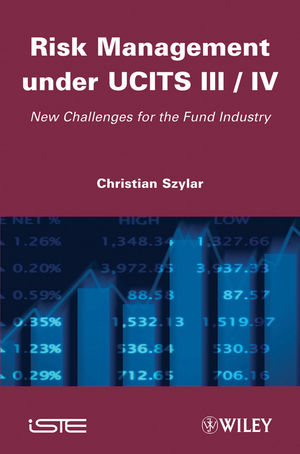Risk Management under UCITS III / IV: New Challenges for the Fund IndustryISBN: 978-1-84821-210-7
Hardcover
272 pages
May 2010, Wiley-ISTE
 |
||||||
Introduction xi
Acknowledgements xv
PART I. WHAT YOU HAVE TO KNOW ABOUT UCITS TO UCITS III 1
Chapter 1. UCITS to UCITS III 3
1.1. UCITS primer and market size 3
1.2. UCITS – a success story: from UCITS to UCITS III/IV 8
1.3. Conclusion – focus on risk management 26
Chapter 2. Risk Management History: From Banks to the Asset Management Industry 33
2.1. Insight on risk management 33
2.2. A Brief History of Risk Management 39
2.3. From Risk Management to Value-at-Risk 49
2.4. From Portfolio Theory and Capital Requirements to UCITS 60
Chapter 3. Definition of the Value-at-Risk 63
3.1. VaR calculation models 65
3.2. Monte Carlo simulation 83
3.3. Conclusion 92
PART II. UCITS RISK MANAGEMENT 95
Chapter 4. UCITS III Risk Management Process and Taxonomy of Risks 97
4.1. Risk manager’s role and responsibilities 97
4.2. Taxonomy of risks 98
Chapter 5. Risk Management Organization 103
5.1. Risk standards 104
5.2. Description of the risk management process (RMP) 113
5.3. UCITS risk management process 117
5.4. Disclosure requirements 122
5.5. CSSF 07/308 124
Chapter 6. Financial Derivative Instruments and UCITS 127
6.1. Swap 127
6.2. Contracts for difference 137
6.3. The forward contract 138
6.4. The futures contract 139
6.5. Options 141
6.6. Warrant 143
Chapter 7. Global Exposure and Leverage 145
7.1. Global exposure – overview 145
7.2. Sophisticated and non-sophisticated UCITS: is there a distinction? 148
7.3. Sophisticated and non-sophisticated UCITS: how to assess market risk/global exposure 150
Chapter 8. Stress Testing 163
8.1. Definition and overview of stress testing 163
8.2. Main approaches 166
8.3. Types of scenarios 167
8.4. Stress test scenarios 171
8.5. Scenario management/stress testing with PMS 174
Chapter 9. Backtesting 177
9.1. Overview 177
9.2. Back-testing may also reveal important limitations of VaR 183
9.3. Back testing with PMS 186
Chapter 10. Counterparty and Issuer Risk, Concentration Limits and Appropriate Cover 191
10.1. Counterparty risk 191
10.2. Issuer risk and concentration limits 196
10.3. Appropriate cover in the absence of cash-settlement 196
Chapter 11. Liquidity Risk 199
11.1. Overview 199
11.2. Assessing liquidity constraints 201
11.3. Estimation of portfolio liquidity based on historical market data 201
11.4. LVaR 206
Chapter 12. Other Risk Indicators that can be used in the Risk Management Process 209
12.1. Market risk 209
12.2. Interest rate risk 213
12.3. The case of Greeks for the options 218
12.4. Conclusion 223
Conclusion 225
Appendices 233
Bibliography 265
Index 271



